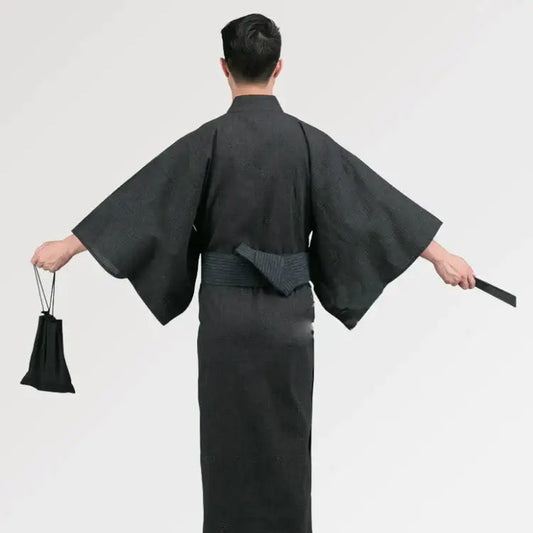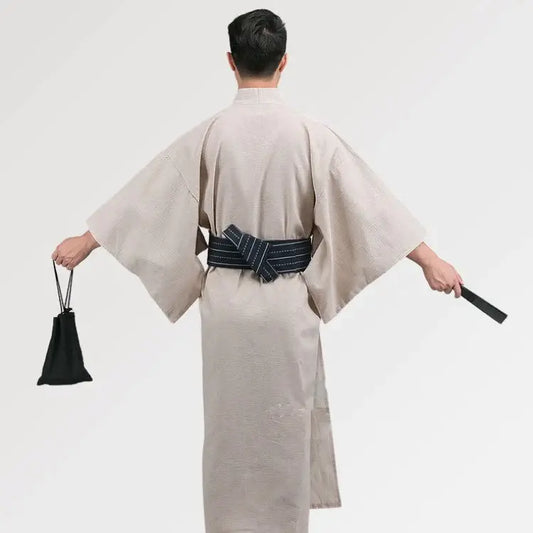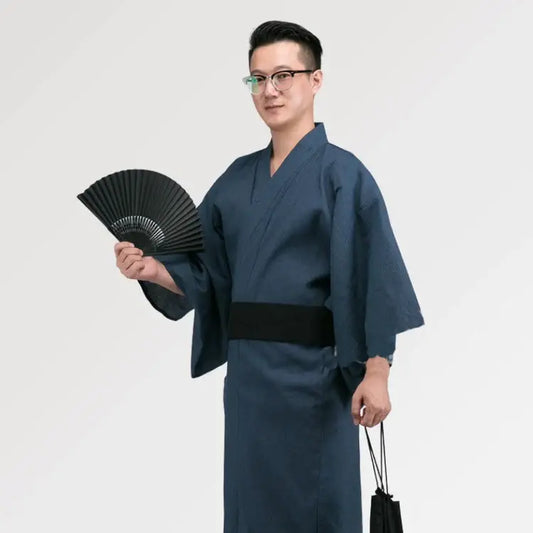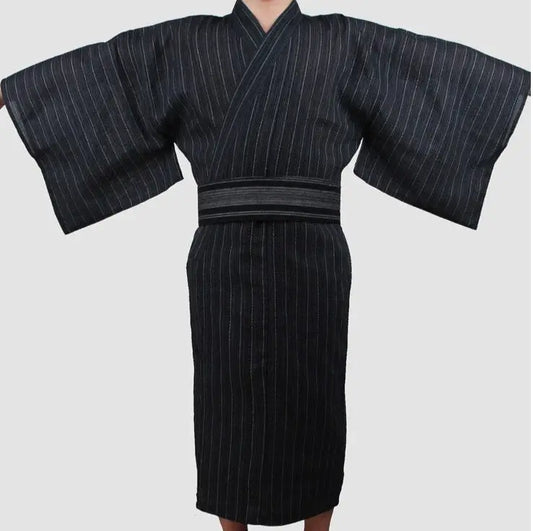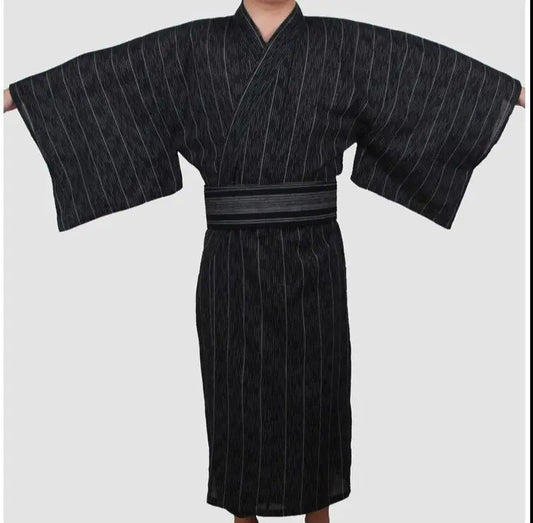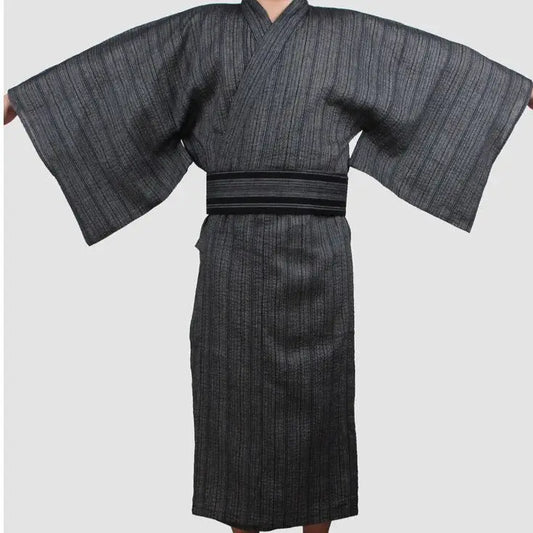Lightness and Tradition: Welcome to the World of Yukata
Step into effortless elegance with the Yukata — Japan's beloved casual kimono that embodies summer breezes, matsuri festivals, and quiet moments of comfort. Light, breathable, and steeped in seasonal charm, the Yukata is the perfect expression of tradition made wearable for everyday joy. 🌸
Unlike its more formal counterpart, the kimono, the Yukata was born from simplicity. Originally a bathrobe for aristocrats in the Heian period, it evolved into a staple for festivals, ryokan stays, and relaxed summer days. Today, the Yukata lives on as a timeless blend of cultural heritage and minimalist fashion.
Our Yukata collection celebrates this history with a range of hand-dyed fabrics, floral motifs, and contemporary reinterpretations. Whether you're dressing for a firework display, a cultural event, or a serene evening at home, there's a Yukata that fits your spirit. ✨
The Story and Symbolism Behind the Yukata
The word Yukata (浴衣) literally means "bathing cloth." Originally made from plain indigo-dyed cotton, it was worn by nobles to dry off after bathing. As public baths (sento) became popular, the Yukata shifted into daily use, eventually becoming the go-to attire for summer festivals and onsen resorts.
Its lightweight, unlined structure and breathable fabric made it perfect for Japan’s humid summer. But beyond comfort, Yukata carry rich symbolism in their prints and patterns:
| Common Motif | Meaning |
|---|---|
| Fireworks (Hanabi) | Celebration, fleeting beauty |
| Goldfish (Kingyo) | Playfulness, summer nostalgia |
| Morning Glories | Transience, purity |
| Dragonflies | Strength, courage, good luck |
| Bamboo & Waves | Resilience, harmony with nature |
Traditional Yukata are still dyed using methods like chusen, where colors merge naturally into cotton. This technique, like the garment itself, embraces imperfection and flow.
Why the Yukata is a Must-Have in Your Wardrobe
The Yukata is so much more than a robe. It's a celebration of culture, a fashion statement, and a comfort garment all in one. Here’s why everyone should own one:
-
Unmatched Comfort: Made from lightweight cotton or linen, Yukata are breathable, soft, and easy to wear.
-
Seasonal Style: Ideal for warm-weather wear, they are the garment of choice during Japan’s summer festivals and fireworks nights.
-
Cultural Expression: Wearing a Yukata is participating in a living tradition that celebrates simplicity and seasonal awareness.
-
Accessible Fashion: Easier to wear and maintain than formal kimono, Yukata are the entry point for anyone curious about Japanese clothing.
-
Versatile Use: From lounging at home to traveling in Japan, Yukata transition from loungewear to outerwear with subtle flair.
Whether you pair it with geta sandals and an obi, or belt it over jeans for a modern twist, the Yukata adapts with grace.
How to Style Your Yukata: Tradition Meets Modern Aesthetic
Styling a Yukata can be a joyful ritual or a casual affair, depending on how you want to wear it. Here are ways to embrace this garment in both traditional and contemporary settings:
-
Traditional Festival Look: Pair with a colorful hanhaba obi (half-width belt), geta sandals, and a drawstring kinchaku bag. Add hair accessories like floral pins or combs.
-
Relaxed Yukata Style: Wear a Yukata loosely tied at home or during onsen stays. Add a soft cotton belt and go barefoot for comfort.
-
Street Chic Fusion: Belt your Yukata with a leather strap or obi over skinny jeans. Pair with ankle boots or sneakers and a crossbody bag.
-
Beach & Resort Wear: A Yukata makes the perfect beach cover-up. Choose pastel or ocean-themed prints and pair with flip-flops or espadrilles.
-
Nightwear Elegance: Use as luxurious sleepwear. Choose softer fabrics with muted tones for an ultra-relaxing experience.
| Look Type | Pair With | Setting |
| Traditional Festival | Obi, Geta, Kinchaku, Hairpins | Summer Festivals, Fireworks, Temples |
| Casual Lounge | Cotton Belt, Slippers | Home, Ryokan, Spa |
| Fashion Fusion | Jeans, Boots, Obi, Crossbody | Urban Outings, Cultural Events |
| Resort Wear | Sandals, Straw Hat, Sunglasses | Beach Trips, Garden Parties |
| Sleepwear Chic | Eye Mask, Light Blanket | Nighttime Comfort, Travel |
No matter how you wear it, the Yukata brings ease, charm, and intention to every step.
Enhancing Your Yukata Look: Perfect Pairings
To fully embody the Yukata spirit, the right accessories and companions are essential. Here’s how to complete your look with harmony and flair:
-
Obi Belts: From simple hanhaba obi to decorative lace versions, the belt is your Yukata’s centerpiece.
-
Footwear: Traditional geta sandals are iconic, but modern wearers also love espadrilles or ballet flats.
-
Hair Accessories: Kanzashi (hairpins), scrunchies with traditional prints, or fresh flowers add a delicate touch.
-
Bags: Kinchaku drawstring pouches, mini rattan handbags, or furoshiki-wrapped totes are stylish and functional.
-
Jewelry & Extras: Keep it subtle with pearl earrings, bangles, or hand fans for elegance and utility.
| Accessory | Why It Works | Pairing Tip |
| Obi Belt | Adds structure and contrast to the Yukata | Match or contrast with Yukata colors |
| Geta Sandals | Traditional and seasonally appropriate | Add heel cushions for long walks |
| Hairpin/Kanzashi | Highlights hairstyle with tradition | Choose floral or seasonal motifs |
| Kinchaku Bag | Compact and culturally complementary | Match fabric pattern or coordinate tones |
| Fan (Uchiwa/Sensu) | Practical, stylish, and symbolic of summer | Tuck into obi for authentic touch |
Details matter. And with the right accessories, your Yukata becomes a complete visual experience.
Live the Yukata Lifestyle: Casual Elegance, Every Day
In a world increasingly drawn to fast fashion and rigid styles, the Yukata offers a breath of fresh air. It invites you to dress with mindfulness, appreciate the changing seasons, and carry yourself with graceful simplicity.
Whether worn in Japan or around the world, the Yukata is a symbol of relaxed elegance. It bridges the gap between heritage and daily life, offering a practical yet poetic way to live.
Explore our curated collection of Yukata to find the pattern and cut that speaks to you. With sizes, colors, and designs for all genders and seasons, there is a Yukata here for every personality and purpose.
Live light. Dress beautifully. Let tradition move with you. 🌟✨


